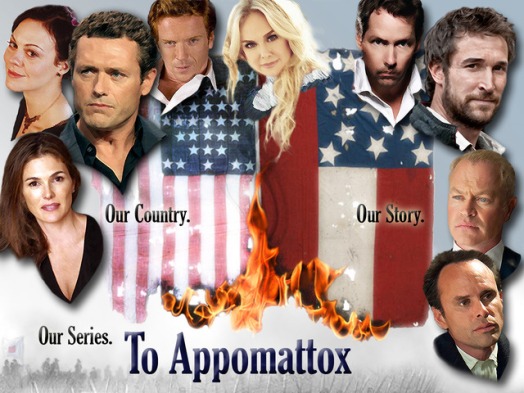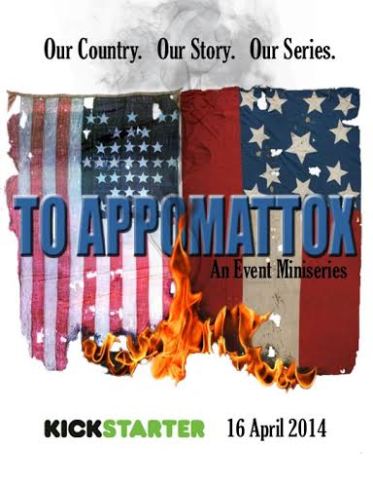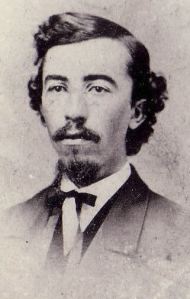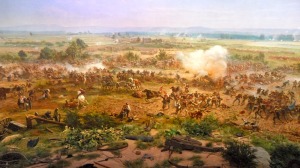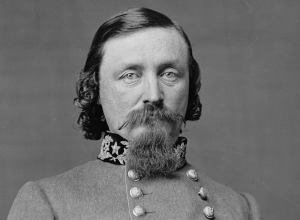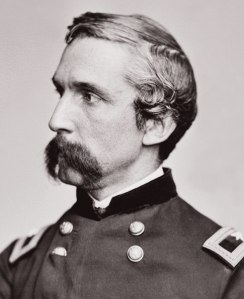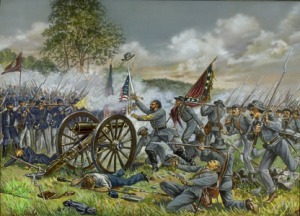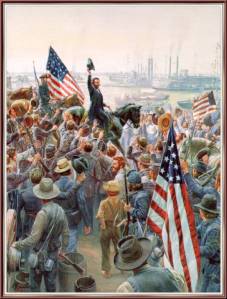
“The Glorious Fourth,” Mort Kunstler’s painting of the victory at Vicksburg
July of 1776 proved to be a pivotal day in the history of the American colonies. In this month, the thirteen separate “countries” finally banded together as one country: the United States of America. On July 2nd, the 2nd Continental Congress, representing all thirteen colonies, unanimously declared independence from Great Britain. John Adams, delegate from Massachusetts, wrote to his wife of the day, stating that July 2nd would “be the most memorable epocha in the history of America. I am apt to believe that it will be celebrated by succeeding generations as the day of deliverance,” to be observed and celebrated “from this time forward forevermore.” He would be right about the celebrations, but proved to be wrong about the date. Two days later, on July 4th, Congress officially adopted Thomas Jefferson’s Declaration of Independence, and was officially made public for the first time. With this action, July 4th would officially be considered Independence Day, as the day that the colonists officially threw off the chains of Great Britain, and created what officially became the United States of America.
87 years later, the very existence of the country those men created was at stake. For the argument over slavery and states’ rights had culminated in the costliest war in American history. At its heart lay not only the existence of the United States as a whole, but the idea of freedom as well. In September of 1862, following the Battle of Antietam, Union President Abraham Lincoln issued the Emancipation Proclamation, declaring freedom to all of those slaves in the states still in rebellion. But Lincoln knew that, for it to truly work, the Union would have to win the war. And by the end of June, 1863, it looked as though the war was turning against the Union yet again. Not only were troops in the west bogged down in an endless siege around Vicksburg, Mississippi, but Confederate troops were again moving north, this time into Pennsylvania. IT seemed that, at this moment, the fate of the nation truly hang in the balance. However, on July 4th, 1863, 87 years to the day of the first public reading of the Declaration of Independence, the tide of war changed in favor of the United States.
The first of these changes, and the one which has been the subject of this series of articles, was the culmination of the Battle of Gettysburg. After three days of brutal fighting (July 1st-3rd), Confederate forces under General Robert E. Lee struggled hard against Union troops under Major General George Gordon Meade. Despite a great amount of courage and heroism, the Confederates were unsuccessful at driving Meade’s troops from the field. After a disastrous attack on July 3rd, an assault that would forever be known as “Pickett’s Charge,” Lee’s troops were beaten. Although official casualties have never been fully confirmed, Confederate losses have been estimated at nearly 28,000 of the 75,000 men in the Army of Northern Virginia, over a third of Lee’s forces. Union casualties numbered nearly 23,000. 51,000 men killed, wounded and captured/missing in three days of fighting. On July 4th, Lee finally acknowledged defeat, and began his retreat back to Virginia. Meade and his troops failed to take the initiative and pursue Lee. By the time they finally moved, Confederates were across the Potomac, and back in Virginia. Lee would never again attempt such an audacious invasion again, and was forced to fight a defensive war that would eventually lead to their ultimate defeat two years later.
On the same day that Lee and the Army of Northern Virginia began the retreat from Gettysburg, Union troops in the western theater achieved an equally important victory. For several weeks, the forces of Major General Ulysses S. Grant had laid siege to the Confederate city of Vicksburg, a vital city along the Mississippi River. At last, with food supplies spent, and the troops no longer able to hold out against the continual assault, the Confederates finally surrendered on July 4th. With Vicksburg gone, control of the Mississippi lay almost entirely in the hands of the Union armies. The Confederacy was officially split in half, and Grant’s start reached its highest peak in the west. With further success at Chattanooga in November, Lincoln knew that Grant was the man who could win the war for him. In March of 1864, Grant was called to Washington, where he was promoted to Lieutenant General, and placed in command of all Union forces in the field. And now, he would face Lee on the fields of Virginia, and one of the greatest contests in military history would soon begin.
With the Union victories at Gettysburg and Vicksburg, the Confederate momentum was officially rocked to its core. With Lee’s great army decimated at Gettysburg, and the vital city of Vicksburg in Union hands, the tide of war shifted to the side of the United States. In less than two years, the war would successfully be won, and the United States restored. It is for this reason that July 4th, 1863, has the right to be called “the Glorious Fourth.”
In the next edition of THE GETTYSBURG DIARY, we will look at Lincoln’s famous address at the dedication of the National Cemetery in Gettysburg, and how his words showed the transformation of the man revered by many as “the Great Emancipator.” Due for release on Tuesday, November 19th, 2013.


